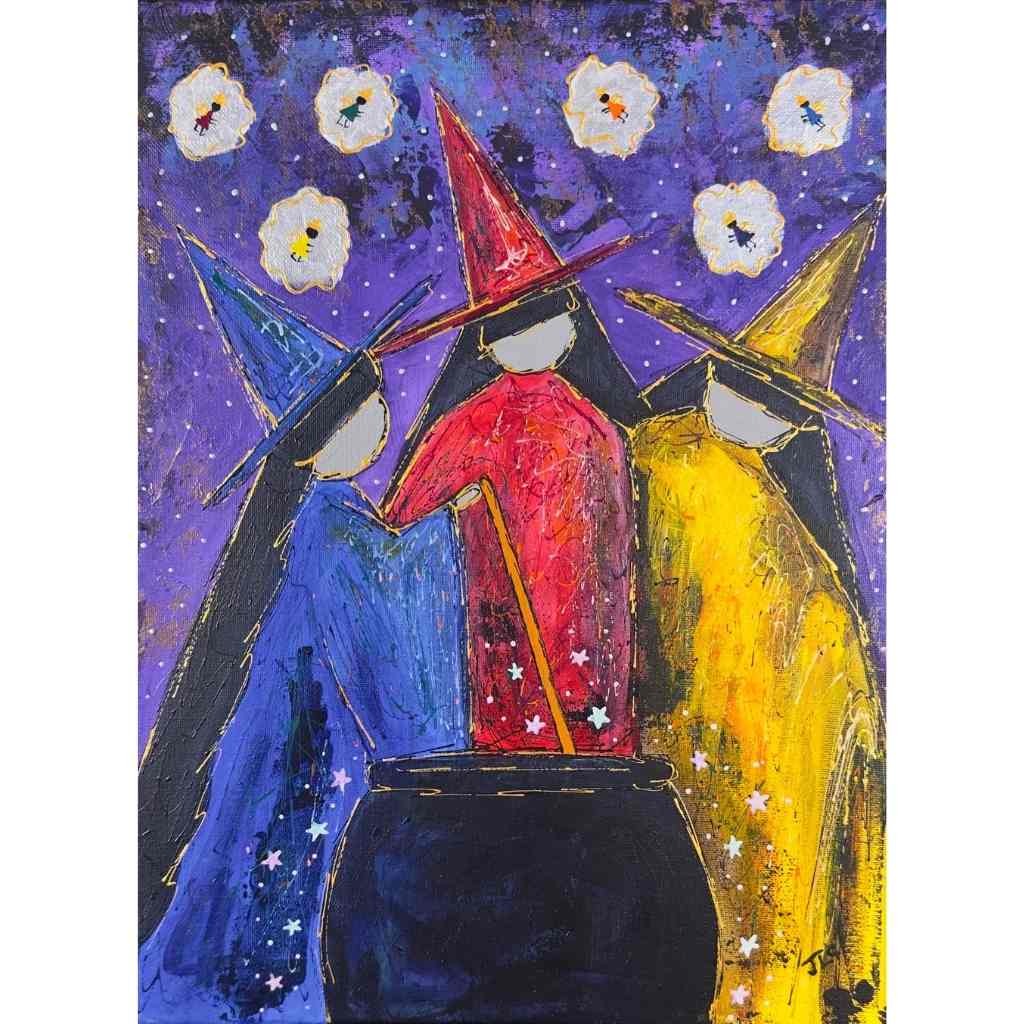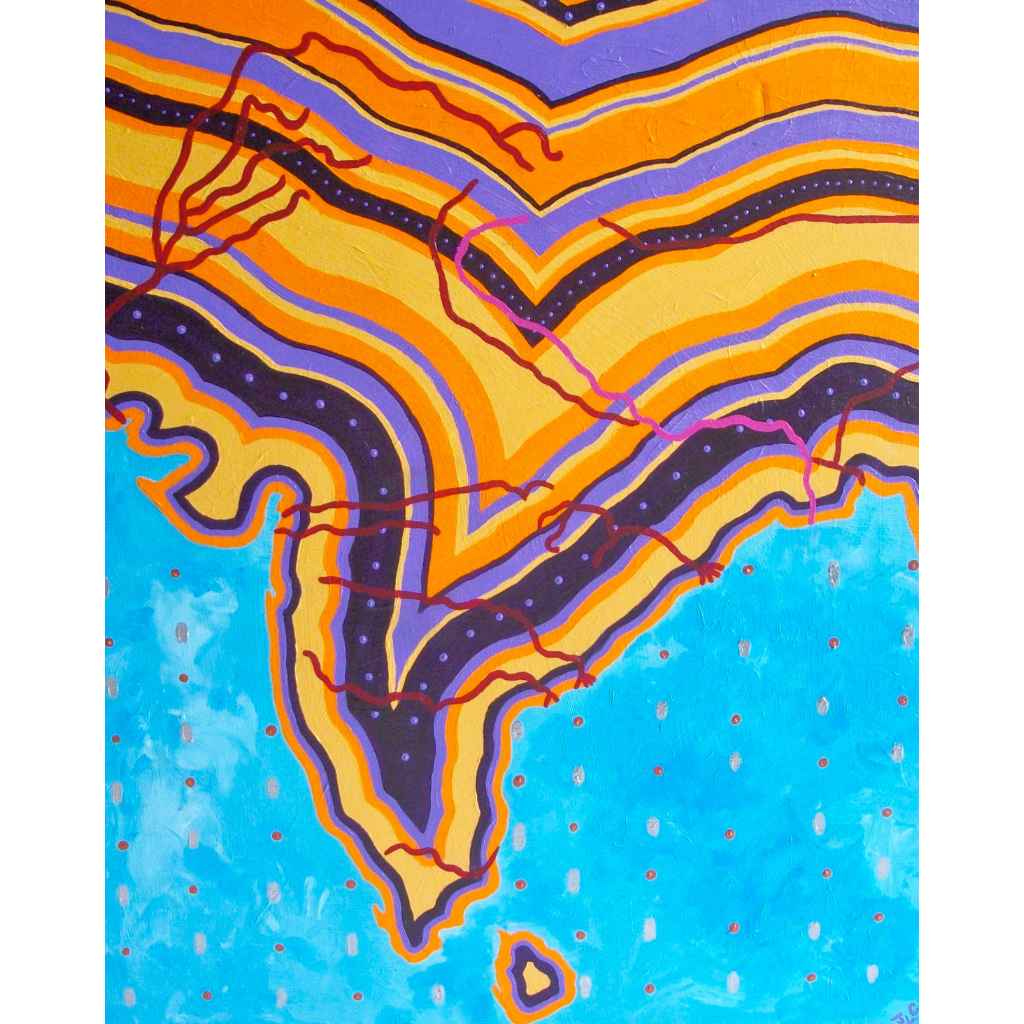Halloween Art: Beyond Spooky to Spiritual Celebration
Halloween art offers a unique opportunity to explore spiritual themes of transformation, ancestral connection, and seasonal wisdom through meaningful imagery that goes far beyond conventional "spooky" decoration. These thoughtful pieces connect us to ancient traditions honoring the thin veil between worlds while celebrating life's eternal cycles. Explore our Skeleton Art Gallery and Witch Art & Fairy Art Gallery to discover Halloween-inspired artwork that brings depth and meaning to your seasonal celebrations.
Table of Contents
- The Spiritual Roots of Halloween
- Reclaiming Halloween from Fear-Based Imagery
- Skeleton Art as Life Celebration
- Witch Art for Seasonal Wisdom
- Ancestral Connection Through Halloween Art
- Colors and Symbols in Spiritual Halloween Art
- Creating Sacred Halloween Spaces
- Halloween Art That Works Year-Round
The Spiritual Roots of Halloween

Halloween's origins in the ancient Celtic festival of Samhain reveal a profound spiritual tradition focused on honoring ancestors, marking seasonal transition, and acknowledging the permeable boundary between physical and spiritual realms. Understanding these roots transforms how we approach Halloween art, shifting from superficial scares to meaningful spiritual expression.
Samhain marked the end of the harvest season and the beginning of winter's introspective period. Celtic communities honored this transition by creating sacred fires, preparing special foods for departed loved ones, and engaging in divination practices to gain wisdom for the coming year. This was a time of reverence, not fear—a celebration of life's continuity across different states of existence.
The "thin veil" concept central to original Halloween traditions refers to the spiritual teaching that certain times of year make communication between worlds easier. Rather than something frightening, this represented an opportunity for guidance, healing, and connection with ancestral wisdom. Contemporary spiritual Halloween art draws from this understanding, creating imagery that feels welcoming rather than threatening.
Modern Halloween art inspired by these authentic traditions features themes of transformation, seasonal celebration, and spiritual communion. Instead of emphasizing fear or death as endings, these pieces explore death as transition and honor the continuing presence of those who have passed into other forms of existence.
Understanding Halloween's spiritual roots helps us appreciate why certain images—skeletons, witches, autumn leaves, harvest imagery—became associated with this season. Each connects to specific spiritual concepts that, when approached thoughtfully, create artwork suitable for meaningful seasonal celebration rather than temporary decoration.
Reclaiming Halloween from Fear-Based Imagery

Contemporary Halloween art offers an opportunity to reclaim this sacred season from commercialized fear-based imagery that dominates popular culture. By choosing artwork that emphasizes spiritual themes over shock value, we can create Halloween decorations that honor the season's deeper meaning while remaining visually appealing and culturally relevant.
Traditional "scary" Halloween imagery often stems from misunderstanding or deliberate distortion of spiritual symbols. Skeletons became frightening "grim reapers" rather than celebration figures. Witches transformed from wise healers into evil villains. Black cats shifted from sacred companions to symbols of bad luck. Spiritual Halloween art reverses these distortions, returning these powerful symbols to their original positive meanings.
The shift from fear-based to spiritual Halloween art doesn't mean avoiding traditional imagery—rather, it means approaching these symbols with understanding and respect. A skeleton in spiritual Halloween art might be depicted dancing with joy, playing music, or engaged in celebration rather than threatening viewers. This connects to Day of the Dead traditions where skeletal figures represent life's vibrancy rather than death's finality.
Witch imagery in spiritual Halloween art emphasizes wisdom, connection to nature, and feminine power rather than malevolence. These figures appear as healers, teachers, or guides—roles that connect to historical witch traditions before persecution created negative associations. Contemporary witch art for Halloween might show magical practitioners engaged in seasonal rituals, herb gathering, or community celebration.
Color palettes in spiritual Halloween art often include traditional autumn colors—oranges, deep reds, golden yellows—but arranged in ways that feel warm and inviting rather than ominous. These natural seasonal colors connect us to harvest abundance and nature's wisdom rather than creating artificial fear responses.
Skeleton Art as Life Celebration
Skeleton art offers one of the most powerful examples of how Halloween imagery can celebrate life rather than fear death. Drawing inspiration from Mexican Day of the Dead traditions, contemporary skeleton art transforms mortality symbols into expressions of joy, continuity, and connection across the boundary between life and death.
In authentic skeleton art, skeletal figures appear engaged in activities they enjoyed during life—playing musical instruments, dancing, cooking, or spending time with loved ones. This imagery reminds viewers that what we love about life continues in some form even after physical existence ends. The skeleton becomes not a symbol of loss but of the essential self that persists beyond bodily limitations.
Day of the Dead-inspired skeleton art often features bright, celebratory colors that emphasize life's vibrancy rather than death's finality. Flowers, particularly marigolds, appear frequently in these compositions, representing the beauty that emerges from life's cycles. Hearts prominently featured in skeleton imagery symbolize how love transcends physical boundaries and continues connecting us across different states of existence.
Musical themes appear frequently in life-celebrating skeleton art, acknowledging music's power to connect people across time and space. Skeleton musicians remind us that the joy we create through artistic expression becomes part of a larger cultural inheritance that outlasts individual lives. These pieces work particularly well in homes where music plays an important role in family life or spiritual practice.
For Halloween display, skeleton art that emphasizes celebration rather than fear creates environments where children and adults can explore mortality themes without developing unhealthy fears. These pieces teaching that death is a natural transition rather than something to dread, while honoring the continuing influence of those who have passed into other forms of existence.
Witch Art for Seasonal Wisdom
Witch art during Halloween season offers opportunities to explore themes of seasonal wisdom, feminine power, and connection to natural cycles through imagery that reclaims the witch archetype from centuries of misrepresentation. These pieces celebrate the wise woman tradition while addressing contemporary spiritual needs for guidance and empowerment.
Seasonal witch art often depicts magical practitioners engaged with autumn's specific energies—harvesting herbs, creating protective amulets for winter, or engaging in divination practices to gain insight for the coming year. These activities connect to practical traditions that helped communities prepare for challenging seasons through both physical and spiritual means.
Harvest imagery in witch art emphasizes abundance and preparation themes appropriate for autumn's energy. Witches might be shown with baskets of apples, bundles of herbs, or jars of preserved foods—images that connect magical practice to the practical wisdom of seasonal living. This approach makes witch art relevant to anyone interested in sustainable living or seasonal awareness.
Divination themes in Halloween witch art—crystal balls, tarot cards, scrying bowls—represent the season's traditional association with seeking guidance for the future. Rather than depicting these practices as mysterious or threatening, spiritual witch art shows them as natural tools for accessing intuitive wisdom and making informed decisions about life's direction.
Color palettes in seasonal witch art often incorporate autumn's natural progression from green abundance through golden harvest to the deeper purples and blacks of late autumn. These colors connect witch imagery to the actual seasonal experience while creating artwork that complements autumn's aesthetic without feeling artificially "spooky."
Contemporary witch art for Halloween might also address modern women's need for empowering imagery that celebrates feminine wisdom, independence, and spiritual authority. These pieces can serve as daily reminders of personal power and connection to ancient traditions of women's spiritual leadership.
Ancestral Connection Through Halloween Art

Halloween art focused on ancestral connection transforms the season's "ghost" imagery into meaningful representations of continuing bonds with loved ones who have died. These pieces create visual frameworks for healthy grief processing and ongoing relationships with family heritage rather than promoting fear of the deceased.
Ancestral altar imagery in Halloween art might show carefully arranged photographs, candles, flowers, and personal mementos creating sacred spaces for remembrance and communication. These compositions demonstrate how to honor the dead through beauty and reverence rather than avoiding or fearing their continuing presence. Such artwork can inspire viewers to create their own ancestral altars during Halloween season.
Family heritage themes in Halloween art connect to the season's traditional emphasis on storytelling and cultural transmission. Images might show elders sharing stories with younger generations, emphasizing how wisdom, traditions, and family connections continue across multiple generations. These pieces celebrate the living bridge between past and future rather than focusing on death as ending.
Portrait-style Halloween art might depict beloved ancestors surrounded by symbols of their lives, interests, or cultural heritage. Rather than presenting deceased loved ones as distant or frightening, these pieces show them as continuing presences in family life whose guidance and love remain accessible to those who remember them with respect and affection.
Dream imagery in ancestral Halloween art acknowledges how deceased loved ones often communicate through dreams and synchronicities. These pieces might show ethereal figures offering guidance, comfort, or simply presence to living family members, normalizing these experiences as part of healthy grief and ongoing relationship rather than supernatural phenomena to fear.
Memorial garden themes combine ancestral connection with nature imagery, showing how loved ones remain present through the plants, places, and natural cycles they cherished during life. These compositions work particularly well for those who find comfort in connecting with deceased loved ones through nature rather than traditional religious frameworks.
Colors and Symbols in Spiritual Halloween Art
The color palette and symbolic elements chosen for spiritual Halloween art dramatically affect its emotional impact and spiritual resonance. Understanding these choices helps in selecting pieces that create the desired atmosphere while honoring the season's deeper meanings rather than simply following commercial Halloween conventions.
Orange in spiritual Halloween art connects to harvest abundance, creative fire, and joyful celebration rather than artificial "spookiness." Deep, rich oranges suggest autumn leaves and harvest pumpkins, while brighter oranges evoke the warmth of community fires and seasonal festivals. Orange creates feelings of warmth, creativity, and social connection—ideal for Halloween celebrations focused on community rather than fear.
Purple in Halloween art represents wisdom, spiritual insight, and the liminal qualities of the season when the veil between worlds grows thin. Deep purples connect to twilight times traditionally associated with spiritual communication, while lighter purples suggest the ethereal qualities of spiritual experience. Purple creates an atmosphere of reverence and mystery without fear.
Gold and yellow in spiritual Halloween art emphasize the season's connection to harvest abundance and spiritual illumination. Golden colors suggest candlelight, autumn leaves, and the precious nature of seasonal wisdom. These warm tones create feelings of prosperity, gratitude, and spiritual richness that support meaningful seasonal celebration.
Black in spiritual Halloween art represents the fertile darkness from which new life emerges rather than death or evil. Like rich soil or the night sky, black provides a foundation for other colors while symbolizing the unknown potential that darkness contains. Used thoughtfully, black creates depth and contemplative space in Halloween artwork.
Symbolic elements in spiritual Halloween art include spirals (representing life's cyclical nature), pentagrams (connecting to earth's elements), harvest imagery (abundance and gratitude), and celestial symbols (cosmic connection). These elements create layers of meaning that reward contemplation while connecting viewers to universal spiritual concepts.
Creating Sacred Halloween Spaces

Spiritual Halloween art enables the creation of sacred seasonal spaces that honor the holiday's deeper meanings while maintaining aesthetic beauty throughout the autumn season. These environments support meaningful seasonal practices while serving as inspiring daily décor that works beyond Halloween night.
Altar spaces enhanced with spiritual Halloween art might combine skeleton imagery honoring deceased loved ones with witch art representing seasonal wisdom and protection. These arrangements create focal points for seasonal meditation, ancestral communication, or simply daily reflection on life's cyclical nature and continuing connections.
Living room spaces benefit from larger Halloween art pieces that serve as conversation starters about seasonal meaning and spiritual traditions. A skeleton painting showing Day of the Dead celebration or witch art depicting seasonal wisdom can spark discussions about cultural traditions, spiritual beliefs, and personal experiences with life's transitions.
Entryway spaces with spiritual Halloween art welcome visitors while setting intentions for seasonal celebration. Images showing harvest abundance, community gathering, or ancestral reverence communicate values of gratitude, connection, and spiritual awareness without the aggressive energy of fear-based Halloween decoration.
Kitchen and dining areas work well with Halloween art emphasizing harvest themes, community gathering, and the preparation of special foods for seasonal celebration. These pieces connect to Halloween's roots in harvest festivals while honoring the continuing tradition of preparing special meals to honor ancestors and celebrate community.
Children's spaces benefit from Halloween art that explores seasonal themes without creating fear or anxiety. Cheerful skeleton figures, wise witch imagery, or harvest celebration scenes help young people understand life's cycles and cultural traditions in age-appropriate ways that build spiritual understanding rather than fear responses.
Meditation or spiritual practice spaces enhanced with thoughtful Halloween art create environments conducive to seasonal spiritual work—whether that involves ancestral communication, seasonal divination, or simply deeper contemplation of life's transitions and continuing cycles.
Halloween Art That Works Year-Round
High-quality spiritual Halloween art transcends seasonal decoration to provide year-round inspiration and beauty in living spaces. By choosing pieces with universal spiritual themes rather than specifically Halloween imagery, collectors can enjoy these meaningful works throughout the year while honoring their seasonal origins.
Skeleton art emphasizing life celebration and ancestral connection works beautifully year-round as reminder of life's preciousness and continuing bonds with loved ones. These pieces serve daily inspiration to live fully while maintaining connection to family heritage and cultural traditions that extend beyond specific holidays.
Witch art focusing on feminine wisdom, connection to nature, and seasonal awareness provides ongoing inspiration for those interested in earth-based spirituality or simply deeper awareness of natural cycles. These pieces support daily spiritual practice while honoring the wisdom traditions that Halloween originally celebrated.
Harvest imagery in Halloween art connects to themes of gratitude, abundance, and community that remain relevant throughout the year. These pieces serve as daily reminders to appreciate life's gifts while acknowledging the work and wisdom required to create abundance in any season.
Ancestral imagery transcends Halloween's specific timeframe to support ongoing relationship with family heritage and cultural wisdom. These pieces create daily opportunities for remembrance, guidance, and connection to the larger story of which individual lives form part.
Color palettes chosen for spiritual Halloween art—deep oranges, rich purples, warm golds—often work beautifully in home décor throughout autumn and winter seasons. These colors create warm, contemplative environments that support seasonal transition and indoor reflection during cooler months.
Universal spiritual symbols featured in Halloween art—spirals, celestial imagery, natural elements—provide ongoing inspiration for spiritual development and connection to larger cosmic patterns. These pieces serve as daily reminders of spiritual principles that extend far beyond seasonal celebration.
Visit our Skeleton Art Gallery and Witch Art & Fairy Art Gallery to discover Halloween-inspired artwork that brings spiritual depth and year-round beauty to your home while honoring the sacred traditions that Halloween originally celebrated.













